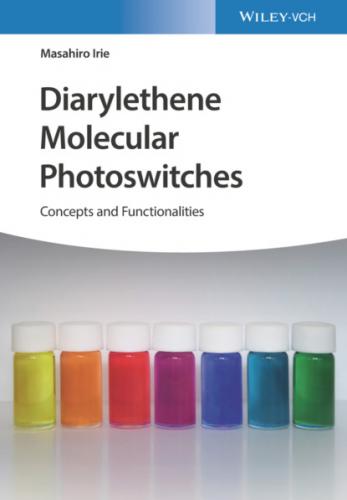1 1 Barltrop, J.A. and Coyle, J.D. (1975). Excited States in Organic Chemistry. London: Wiley.
2 2 Turro, N.J. (1978). Modern Molecular Photochemistry. Menlo Park, CA: Benjamin/Cummings Pub.
3 3 Balzani, V., Ceroni, P., and Juris, A. (2014). Photochemistry and Photophysics: Concept, Research, Applications. Weinheim: Wiley‐VCH.
4 4 Brown, G.H. (1971). Photochromism. New York: Wiley‐Interscience.
5 5 Crano, J.C. and Guglielmetti, R.J. (1998). Organic Photochromism and Thermochromic Compounds. New York: Plenum Press.
6 6 Bouas‐Laurent, H. and Dürr, H. (2001). Organic photochromism. Pure Appl. Chem. 73: 639–665.
7 7 Dürr, H. and Bouas‐Laurent, H. (eds.) (2003). Photochromism: Molecules and Systems. Amsterdam: Elsevier.
8 8 Irie, M., Yokoyama, Y., and Seki, T. (eds.) (2013). New Frontiers in Photochromism. Tokyo: Springer.
9 9 Tian, H. and Zhang, J. (eds.) (2016). Photochromic Materials: Preparation, Properties and Applications. Weinheim: Wiley‐VCH.
10 10 Yokoyama, Y. and Nakatani, K. (eds.) (2017). Photon‐Working Switches. Tokyo: Springer.
11 11 Hartley, G.S. (1937). The cis‐form of azobenzene. Nature 140: 281.
12 12 Fischer, E. and Hirshberg, Y. (1952). Formation of coloured forms of spiropyrans by low‐temperature irradiation. J. Chem. Soc.: 4522–4524.
13 13 Iwahori, F., Hatano, S., and Abe, J. (2007). Rational design of a new class of diffusion‐inhibited HABI with fast back‐reaction. J. Phys. Org. Chem. 20: 857–863.
14 14 Hampson, G.C. and Robertson, J.M. (1941). Bond lengths and resonance in the cis‐azobenzene molecule. J. Chem. Soc.: 409–413.
15 15 Bullock, D.J.W., Cumper, C.W.N., and Vogel, A.I. (1965). Physical properties and chemical constitution. Part XLLIII. The electric dipole moments of azobenzene, azopyridines, and azoquinolines. J. Chem. Soc.: 5316–5323.
16 16 Malic, E., Weber, C., Richter, M. et al. (2011). Microscopic model of the optical absorption of carbon nanotubes functionalized with molecular spiropyran photoswitches. Phys. Rev. Lett. 106: 097401.
17 17 Kryszewski, M., Nadolski, B., North, A.M., and Pethrick, R.A. (1980). Kinetic matrix effects (response and density distribution function): ring closure reaction of indolinobenzospiropyrans in glassy poly(alkyl methacrylates). J. Chem. Soc., Faraday Trans II 76: 351–368.
18 18 Fujita, K., Hatano, S., Kato, D., and Abe, J. (2008). Photochromism of a radical diffusion‐inhibited hexaarylbiimidazole derivative with intense coloration and fast decolouration performance. Org. Lett. 10 (14): 3105–3108.
19 19 Heller, H.G. and Oliver, S. (1981). Photochromic heterocyclic fulgides. Part 1. Rearrangement reactions of (E)‐α‐3‐furylethylidene(isopropylidene)succinic anhydride. J. Chem. Soc. Perkin Trans. 1: 197–201.
20 20 Irie, M. and Mohri, M. (1988). Thermally irreversible photochromic systems. Reversible photocyclization of diarylethene derivatives. J. Org. Chem. 53 (4): 803–808.
21 21 Irie, M. (2000). Diarylethenes for memories and switches. Chem. Rev. 100 (5): 1685–1716.
22 22 Irie, M., Fukaminato, T., Matsuda, K., and Kobatake, S. (2014). Photochromism of diarylethene molecules and crystals: memories, switches and actuators. Chem. Rev. 114: 12174–12277.
23 23 Irie, M. (1990). Photoresponsive polymers. Adv. Polym. Sci. 94: 27–67.
24 24 Irie, M., Hirano, Y., Hashimoto, S., and Hayashi, K. (1981). Photoresponsive polymers. 2. Reversible solution viscosity change of polyamides having azobenzene residues in the main chain. Macromolecules 14 (2): 262–267.
25 25 Irie, M. and Schnabel, W. (1981). Photoresponsive polymers. On the dynamics of conformational changes of polyamides with backbone azobenzene groups. Macromolecules 14 (5): 1246–1249.
26 26 Irie, M. and Tanaka, H. (1983). Photoresponsive polymers. 5. Reversible solubility change of polystyrene having azobenzene groups. Macromolecules 16 (2): 210–214.
27 27 Irie, M. and Schnabel, W. (1985). On the dynamics of photostimulated conformational change of polystyrene with pendant azobenzene groups in solution. Macromolecules 18 (3): 394–398.
28 28 Irie, M. and Iga, R. (1986). Photoresponsive polymers. 9. Photostimulated reversible sol‐gel transition of polystyrene with pendant azobenzene groups in carbon disulfide. Macromolecules 19 (10): 2480–2484.
29 29 Irie, M. and Schnabel, W. (1982). Photochemical conversion of poly‐2,3‐diphenylbutadiene to poly‐9,10‐dimethylenephenanthrene. Eur. Polym. J. 18: 15–18.
30 30 Hanazawa, M., Sumiya, R., Horikawa, Y., and Irie, M. (1992). Thermally irreversible photochromic systems. Reversible photocyclization of 1,2‐bis(2‐methylbenzo[b]thiophen‐3‐yl)perfluorocycloalkene derivatives. J. Chem. Soc., Chem. Commun. 3: 206–207.
31 31 Uno, K., Niikura, H., Morimoto, M. et al. (2011). In situ preparation of highly fluorescent dyes upon photoirradiation. J. Am. Chem. Soc. 133: 13558–13564.
2.1 Basic Concepts
Thermal irreversibility is an essential and indispensable property for the applications of molecular photoswitches to memory media and switches. Although tremendous efforts were made in the 1970–1980s to provide the thermal irreversibility to molecular photoswitches, all attempts to modify existing photoswitchable molecules failed. We had to wait until the thermally stable molecular photoswitches were serendipitously discovered. In the beginning and the middle of the 1980s, it was found that furylfulgides and diarylethenes undergo thermally irreversible photoswitching. The photogenerated colored isomers practically never revert back to the colorless isomers at room temperature. Although they undergo thermally irreversible photoswitching, the reason why the molecules show the thermal stability was not understood. It was a crucial task to reveal the reason. The basic principle behind the thermally irreversible photoswitching reactivity was elucidated using both theoretical and experimental approaches, as follows.
The 2,3‐diphenyl‐2‐butene unit, shown in Figure 1.3, underwent a thermally reversible photoswitching reaction in a deaerated solution, while the 2,3‐di(2,5‐dimethyl‐3‐thienyl)‐2‐butene unit, shown in Figure 1.4B(b) exhibited a thermally irreversible reactivity. The photogenerated closed‐ring form of 2,3‐di(2,5‐dimethyl‐3‐thienyl)‐2‐butene was found to remain stable and practically never returned to the open‐ring form at room temperature. In addition, the open‐ring isomer was stable even at elevated temperatures and no thermochromic reaction was observed. To reveal the reason why the diarylethene having phenyl rings and that having thiophene rings exhibit such a different reactivity, semiempirical modified neglect of diatomic overlap (MNDO) calculation was carried out for diarylethene derivatives 9–12 (Scheme 2.1) [1].
Scheme 2.1 Electrocyclic reactions of diarylethenes 9−12.
For electrocyclic reactions, two modes of geometrical structure changes, conrotatory and disrotatory, are distinguished, as shown in Scheme 2.2. According to the Woodward‐Hoffmann rule [2] based on π‐orbital symmetries for 1,3,5‐hexatriene (HT), which is the simplest molecular framework of the above molecules, the conrotatory cyclization reaction to cyclohexadiene (CHD) is brought about by light and the disrotatory
